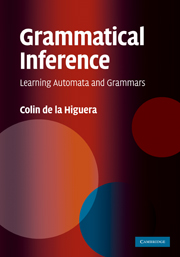Book contents
- Frontmatter
- Contents
- Preface
- Acknowledgements
- 1 Introduction
- 2 The data and some applications
- Part I The Tools
- Part II What Does Learning a Language Mean?
- Part III Learning Algorithms and Techniques
- 11 Text learners
- 12 Informed learners
- 13 Learning with queries
- 14 Artificial intelligence techniques
- 15 Learning context-free grammars
- 16 Learning probabilistic finite automata
- 17 Estimating the probabilities
- 18 Learning transducers
- 19 A very small conclusion
- References
- Index
16 - Learning probabilistic finite automata
from Part III - Learning Algorithms and Techniques
Published online by Cambridge University Press: 05 July 2014
- Frontmatter
- Contents
- Preface
- Acknowledgements
- 1 Introduction
- 2 The data and some applications
- Part I The Tools
- Part II What Does Learning a Language Mean?
- Part III Learning Algorithms and Techniques
- 11 Text learners
- 12 Informed learners
- 13 Learning with queries
- 14 Artificial intelligence techniques
- 15 Learning context-free grammars
- 16 Learning probabilistic finite automata
- 17 Estimating the probabilities
- 18 Learning transducers
- 19 A very small conclusion
- References
- Index
Summary
En efecto, las computadoras parten del sofisma, políticamente inaceptable, de que dos y dos son cuatro. Su conservadurismo es feroz en este respeto.
Pablo de la Higuera, In, Out, Off… ¡Uf!The promiscuous grammar has high a priori probability, but assigns low probability to the data. The ad-hoc grammar has very low a priori probability, but assigns probability one to the data. These are two extreme grammar types: the best choice is usually somewhere between them.
Ray Solomonoff (Solomonoff, 1997)A language is a set of strings, and a string either belongs to a language or does not. An alternative is to define a distribution over the set of all strings, and in some sense the probability of a string in this set is indicative of its importance in the language. This distribution, if learnt from data, can in turn be used to disambiguate, by inding the most probable string corresponding to a pattern, or to predict by proposing the next symbol for a given preix.
We propose in this chapter to investigate ways of learning distributions representable by probabilistic automata from strings. No extra knowledge is usually provided. In particular the structure of the automaton is unknown. The case where the structure is known corresponds to the problem of probability estimation and is discussed in Chapter 17.
We only work in this chapter with deterministic probabilistic finite automata.
- Type
- Chapter
- Information
- Grammatical InferenceLearning Automata and Grammars, pp. 329 - 356Publisher: Cambridge University PressPrint publication year: 2010



